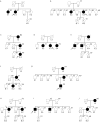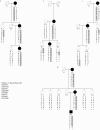Familial isolated hyperparathyroidism is linked to a 1.7 Mb region on chromosome 2p13.3-14
- PMID: 16525030
- PMCID: PMC2563254
- DOI: 10.1136/jmg.2005.035766
Familial isolated hyperparathyroidism is linked to a 1.7 Mb region on chromosome 2p13.3-14
Abstract
Background: Familial isolated hyperparathyroidism (FIHP) is an autosomal dominantly inherited form of primary hyperparathyroidism. Although comprising only about 1% of cases of primary hyperparathyroidism, identification and functional analysis of a causative gene for FIHP is likely to advance our understanding of parathyroid physiology and pathophysiology.
Methods: A genome-wide screen of DNA from seven pedigrees with FIHP was undertaken in order to identify a region of genetic linkage with the disorder.
Results: Multipoint linkage analysis identified a region of suggestive linkage (LOD score 2.68) on chromosome 2. Fine mapping with the addition of three other families revealed significant linkage adjacent to D2S2368 (maximum multipoint LOD score 3.43). Recombination events defined a 1.7 Mb region of linkage between D2S2368 and D2S358 in nine pedigrees. Sequencing of the two most likely candidate genes in this region, however, did not identify a gene for FIHP.
Conclusions: We conclude that a causative gene for FIHP lies within this interval on chromosome 2. This is a major step towards eventual precise identification of a gene for FIHP, likely to be a key component in the genetic regulation of calcium homeostasis.
Conflict of interest statement
Competing interests: none declared
References
-
- Silverberg S, Bilezikian J. Primary hyperparathyroidism. In: Becker K, ed. Principles and practice of endocrinology and metabolism, 3rd ed. Philadelphia: Lippincott, Williams and Wilkins, 2001564–574.
-
- Bilezikian J, Potts J T, Jr, Fuleihan Gel‐H, Kleerekoper M, Neer R, Peacock M, Rastad J, Silverberg S J, Udelsman R, Wells S A. Summary statement from a workshop on asymptomatic primary hyperparathyroidism: a perspective for the 21st century. J Clin Endocrinol Metab 200287(12)5353–5361. - PubMed
-
- Simonds W F, James‐Newton L A, Agarwal S K, Yang B, Skarulis M C, Hendy G N, Marx S J. Familial isolated hyperparathyroidism: clinical and genetic characteristics of 36 kindreds. Medicine 2002811–26. - PubMed
-
- Warner J, Epstein M, Sweet A, Singh D, Burgess J, Stranks S, Hill P, Perry‐Keene D, Learoyd D, Robinson B, Birdsey P, Mackenzie E, Teh B T, Prins J B, Cardinal J. Genetic testing in familial isolated hyperparathyroidism: unexpected results and their implications. J Med Genet 200441(3)155–160. - PMC - PubMed
-
- Simonds W F, Robbins C M, Agarwal S K, Hendy G N, Carpten J D, Marx S J. Familial isolated hyperparathyroidism is rarely caused by germline mutation in HRPT2, the gene for the hyperparathyroidism‐jaw tumor syndrome. J Clin Endocrinol Metab 200489(1)96–102. - PubMed
Publication types
MeSH terms
Substances
LinkOut - more resources
Full Text Sources
Miscellaneous




